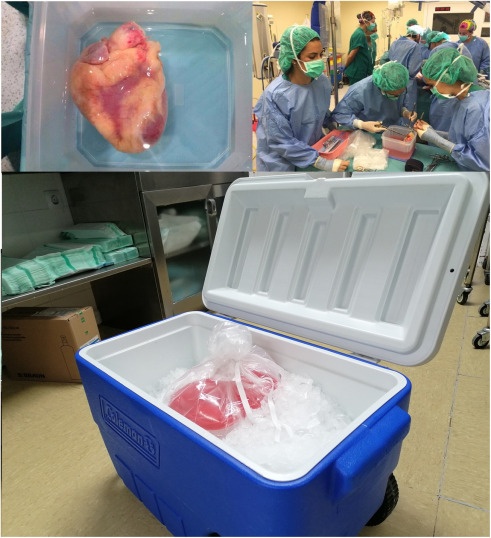

CELSIOR SOLUTION FOR ORGAN PRESERVATION

Ask a doctor about a prescription for CELSIOR SOLUTION FOR ORGAN PRESERVATION

How to use CELSIOR SOLUTION FOR ORGAN PRESERVATION
Introduction
Package Leaflet: Information for the User
Celsior Solution for Organ Preservation
Glutathione, Mannitol, Lactobionic Acid, Glutamic Acid, Sodium Hydroxide,
Calcium Chloride 2H2O, Potassium Chloride, Magnesium Chloride 6H2O, Histidine,
Readthe entire package leafletcarefully before starting to use this medicine,as it contains important information for you.
- Keep this package leaflet, as you may need to read it again.
- If you have any further questions, ask your doctor or pharmacist.
- If you experience any side effects, talk to your doctor or pharmacist, even if they are not listed in this package leaflet. See section 4.
Contents ofthe package leaflet:
- What is Celsior and what is it used for
- What you need to know before using Celsior
- How to use Celsior
- Possible side effects
- Storage of Celsior
- Contents of the pack and further information.
1. What is Celsior and what is it used for
Pharmacotherapeutic group: solvents and diluents, including washing solutions.
Solution for the preservation of thoracic (heart and lung) and abdominal (kidney, liver, and pancreas) organs during transplantation: from the moment of organ removal from the donor, as well as during storage, transport, and until transplantation in the recipient.
2. What you need to know before using Celsior
Do not use Celsior:
Celsior must not be used if the donor or recipient is allergic (hypersensitive) to the active substances or to any of the other components of this medicine (listed in section 6).
Warnings and precautions
Celsior is not suitable for direct injection or intravenous use in the organ recipient and must be used only for the washing and cold storage of solid organs.
Celsior is for single use only. It is not suitable for use in machines that continuously pump the preservation solution through the organ (simulating blood circulation).
Using Celsior with other medicines
No interactions are known when used as instructed.
Tell your doctor or pharmacist if you are taking, have recently taken, or might take any other medicines.
Pregnancy and breastfeeding
If you are pregnant or breastfeeding, think you may be pregnant, or plan to become pregnant, consult your doctor or pharmacist before using this medicine.
No data are available. Since Celsior is not administered systemically to organ recipients, no specific side effects of the solution are expected.
3. How to use Celsior
Celsior must be used only by qualified healthcare professionals, as described in the section entitled: The following information is intended exclusively for medical or healthcare professionals.
Once the organ has been removed from the donor, before transplanting it into the recipient, it has no blood or oxygen supply and needs to be stored at a temperature between 2 and 8°C to function properly in the recipient. Normally, organs are washed to remove blood and to cool them down, which slows down their metabolism. The organ is immediately placed in a sterile container filled with Celsior solution and kept cool, but not frozen.
4. Possible side effects
Like all medicines, this medicine can cause side effects, although not everybody gets them.
Since Celsior is not administered to organ recipients, no specific side effects of the solution are expected. However, you should immediately report any side effects, including those related to other medicines you take during transplantation, to assess what adaptive measures are necessary.
You may experience an abnormal heart rate or low blood pressure. Patients who receive a heart transplant may have abnormal heart function. An increase in the solution greater than recommended may lead to an increase in body fluids and abnormal amounts of salt in the body.
Reporting of side effects
If you experience any side effects, talk to your doctor or nurse, even if they are not listed in this package leaflet. You can also report them directly through the Spanish Medicines Monitoring System: www.notificaRAM.es. By reporting side effects, you can help provide more information on the safety of this medicine.
5. Storage of Celsior
- Keep this medicine out of the sight and reach of children.
- Do not use this medicine after the expiry date stated on the outer packaging after EXP. The expiry date is the last day of the month indicated.
- Store in the original packaging to protect from light. Store and transport refrigerated (between 2°C and 8°C). Do not freeze.
- After opening Celsior, it must be used within 24 hours.
- Do not use this medicine if you notice particles, the solution is not transparent, or if it is not colorless or slightly yellowish.
- Medicines should not be disposed of via wastewater or household waste. Ask your pharmacist how to dispose of medicines no longer required. This will help protect the environment.
6. Contents of the pack and further information
Composition of Celsior
The active substances are glutathione, mannitol, lactobionic acid, glutamic acid, sodium hydroxide, calcium chloride, potassium chloride, magnesium chloride, and histidine.
Each 1-liter bag of solution contains
Glutathione 0.921 g (3 mmol)
Mannitol 10.930 g (60 mmol)
Lactobionic acid 28.664 g (80 mmol)
Glutamic acid 2.942 g (20 mmol)
Sodium hydroxide 4.000 g (100 mmol)
Calcium chloride dihydrate 0.037 g (0.25 mmol)
Potassium chloride 1.118 g (15 mmol)
Magnesium chloride hexahydrate 2.642 g (13 mmol)
Histidine 4.650 g (30 mmol)
The other components (excipients) are:
Water for injection
Sodium hydroxide 1N, 4% (for pH adjustment)
Appearance of the product and pack contents
Celsior is a ready-to-use solution (for single use) in a 1-liter plastic bag with a sachet containing oxygen-absorbing substances. These bags are stored in an outer aluminum-protected box.
Solution for organ preservation.
Celsior is a clear, colorless, or slightly yellowish solution in a bag made of an ethylene-vinyl acetate copolymer, inside an outer aluminum packaging containing an oxygen absorber.
pH = 7.3
Osmolality: 320 mosmol/kg
Multi-packs with 4 bags of 1 liter of solution
Marketing authorization holder and manufacturer
Marketing authorization holder
Institut Georges Lopez - IGL
1 allee des Chevreuils - Route Nationale 6 Parc Tertiaire du Bois Dieu,
F-69380- Lissieu
France
Tel.: 00.800.1212.5656
Manufacturer
6 route de Saint Bonnet
69930 Saint-Laurent-de-Chamousset
France
This medicine is authorized in the Member States of the European Economic Area under the following names:
Austria Celsior Organkonservierungslösung
Germany Celsior Organkonservierungslösung
France Celsior solution pour conservation d’organes
Ireland Celsior Solution for organ preservation
Italy Celsior soluzione per conservazione di organi
Portugal Celsior solução para conservação de órgãos
Spain Celsior solución para la conservación de órganos
Date of last revision of this package leaflet: 05/2017.
---------------------------------------------------------------------------------------------------------
This information is intended exclusively for healthcare professionals:
Special warnings and precautions for use
Celsior is not suitable for direct injection or intravenous use in the recipient and must be used only for the washing and cold storage of solid organs.
Celsior is for single use only. Do not reuse. It is not suitable for continuous perfusion machines.
It cannot be excluded that residual amounts of the solution may cause arrhythmia when the clamp is removed, or that in the case of non-optimal heart preservation in the immediate post-transplant phase, heart failure may be observed.
Handling
Store in a refrigerator (2° to 8° C). Do not freeze. Keep the bag in the outer aluminum-protected container to protect it from light.
The solution may turn yellowish during storage. This does not affect the quality and efficacy of Celsior.
Although the packaging materials have been manufactured under sterile conditions, the outside of the Celsior bag is not sterile. The outside of the bag must be decontaminated if Celsior is to be poured.
It is not necessary to filter the solution before use.
The outer aluminum-protected bag contains oxygen-absorbing substances in a separate sachet that ensures better stability of the reduced glutathione active substance. The contents of this sachet must not be mixed with the solution.
The outer aluminum packaging and the sachet with oxygen-absorbing substances must be removed before use.
As soon as the outer packaging has been removed, check for leaks in the inner container by pressing the bag. If leaks are found, the solution must not be used.
The Celsior bag has 3 openings. The needle of the tube used to wash the organ must be inserted into the left-hand opening of the bag (with a screw thread). Until infusion is started, the tube must be clamped.
The solution bag must be placed inside a blood pressure cuff of suitable size. The cuff must be inflated to apply sufficient pressure to make the liquid flow. Additionally, before infusion, the solution container must be suspended from a sufficient height to ensure a continuous flow of the solution.
Administration / posology
The organ is washed through a cannula inserted into an artery, while maintaining sufficient pressure to obtain a constant flow of the solution to achieve adequate washing. In the case of liver transplantation, the biliary tree is normally washed after removal, before placing it in the preservation and transport container.
The volume of the washing solution depends on the organ.
Suggested minimum volumes:
Heart: adult: 1-2 liters; children: 30 ml/kg
Lung: 4-6 liters
Liver: adult: 6-8 liters;
Kidney: 4-5 liters;
Pancreas: 4 liters.
Multi-organ: according to the relevant organs.
The washing must continue until the organ is uniformly pale and the solution coming out is relatively transparent.
After removal from cold storage (2-8°C), the cold solution must be used immediately.
Pediatric patients
Although experience in children and adolescents is limited, there are no objections to the use of Celsior in this patient group.
Cold storage conditions
The organ is stored at 5 ± 3°C in a sterile container of suitable size for the organ. The organ must be completely covered by the cold solution. The container for organ preservation must be sealed aseptically.
Then, it must be placed in at least one additional container that must be filled with ice, but the ice must not enter the container for organ preservation, as it could come into direct contact with the organ. Care must be taken to ensure that the organ is stored aseptically in its container, i.e., the interior of the container for organ preservation and its contents must remain sterile.
Additional containers must be sealed securely.
Organ preservation containers must be kept inside a well-insulated transport container. Organ preservation containers must be surrounded by ice.
Transport times must be as short as possible.
- Country of registration
- Availability in pharmaciesSupply issue reported
- Prescription requiredYes
- Manufacturer
- This information is for reference only and does not constitute medical advice. Always consult a licensed doctor before taking any medication. Oladoctor is not responsible for medical decisions based on this content.
- Alternatives to CELSIOR SOLUTION FOR ORGAN PRESERVATIONManufacturer: B Braun Medical S.A.Prescription requiredManufacturer: Oiarso Sociedad CooperativaPrescription requiredManufacturer: Fresenius Kabi España, S.A.U.Prescription required
Alternatives to CELSIOR SOLUTION FOR ORGAN PRESERVATION in other countries
The best alternatives with the same active ingredient and therapeutic effect.
Alternative to CELSIOR SOLUTION FOR ORGAN PRESERVATION in Poland
Alternative to CELSIOR SOLUTION FOR ORGAN PRESERVATION in Ukraine
Online doctors for CELSIOR SOLUTION FOR ORGAN PRESERVATION
Discuss dosage, side effects, interactions, contraindications, and prescription renewal for CELSIOR SOLUTION FOR ORGAN PRESERVATION – subject to medical assessment and local rules.














